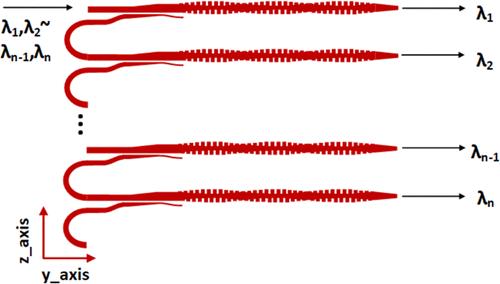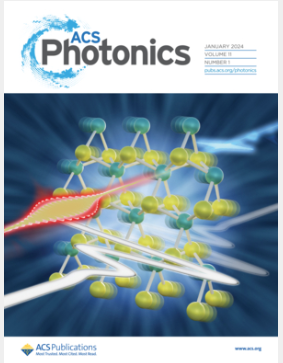用于密集波分复用的多通道绝缘体上铌酸锂光子滤波器
IF 6.5
1区 物理与天体物理
Q1 MATERIALS SCIENCE, MULTIDISCIPLINARY
引用次数: 0
摘要
本文章由计算机程序翻译,如有差异,请以英文原文为准。

Multichannel Lithium-Niobate-On-Insulator Photonic Filter for Dense Wavelength-Division Multiplexing
A multichannel lithium-niobate-on-insulator (LNOI) photonic filter for dense wavelength-division multiplexing (DWDM) is proposed and realized for the first time by introducing high-order 1 × 2 Fabry–Perot (FP) cavity filters in cascade. These 1 × 2 FP cavity filters are developed with a high-order FP cavity consisting of three multimode waveguide gratings (MWGs) and a mode (de) multiplexer for achieving flat-top spectral responses. Such an MWG-based LNOI photonic filter is circulator-free and convenient to be cascaded for working with multiple channels. In addition, there are no bends introduced in the cavities, which enables an extensive free spectral range (FSR) owing to the ultracompactness of the cavity. As an example, a 6-channel LNOI photonic filter is designed and fabricated for DWDM with a channel spacing of 3.2 nm. It shows that the measured 3 dB bandwidth is ∼1.4 nm, and the extinction ratio is up to 38 dB, while the excess loss is ∼0.5 dB, and the interchannel crosstalk is <−25 dB. Besides, an 8 nm × 1.6 nm LNOI DWDM filter is also developed, exhibiting an excess loss of ∼0.5 dB and interchannel crosstalk of <−18 dB. The present devices show great potential as a promising option for realizing future high-capacity optical interconnects.
求助全文
通过发布文献求助,成功后即可免费获取论文全文。
去求助
来源期刊

ACS Photonics
NANOSCIENCE & NANOTECHNOLOGY-MATERIALS SCIENCE, MULTIDISCIPLINARY
CiteScore
11.90
自引率
5.70%
发文量
438
审稿时长
2.3 months
期刊介绍:
Published as soon as accepted and summarized in monthly issues, ACS Photonics will publish Research Articles, Letters, Perspectives, and Reviews, to encompass the full scope of published research in this field.
 求助内容:
求助内容: 应助结果提醒方式:
应助结果提醒方式:


